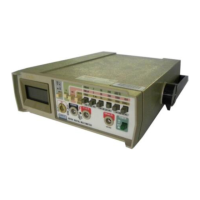APPLICATIONS
Measuring Resistance
The
resistance
in
the
test
leads can
diminish
accuracy on
the
lowest
(400-ohm) range.
The error is usually
0.1
to 0.2 ohms for
a standard pair of
test leads. To determine the error, short the
test leads together
and read the resistance of the leads. Use
the Relative (REL) mode to
automatically
subtract
the
lead
resistance
from resistance measurements.
When measuring resistance, be sure
that the contact between
the probes and the circuit under test
is good. Dirt, oil, solder
flux,
or other foreign
matter seriously
affect resistance.
Most in-circuit
resistance measurements
can
be
made with-
out removing
diodes
and transistors from the circuit The full-
scale measurement
voltage produced
on ranges
below
40 MO
does not
forward-bias silicon diodes or transistor
junctions
enough
to
cause
them to
conduct.
Use the
highest
range
you
can
(except 40 MO) to minimize the possibility
of turning on
diodes ortransistor junctions.
Full-scale
measurement voltage
in the 40-MQ range does
forward-bias a diode or transistor
enough to cause it to
conduct.
In
resistance (and
all other functions
except current), the
mA
(iA input is
connected to a 1-kilohm resistor.
If the
mA
jjA
input
protection fuse is
good,
this input
can be used
as a partial
check of proper operation in resistance. The
input
20
receptacles have split contacts;
touch the
probe to
the half
nearest the LCD. The 1-kilohm
resistor
is
protected by
a
3-diode clamp.
Do not apply external
voltage;
it may blow
the
fuse.
Using
Conductance
for High Resistance
or Leakage
Tests
Conductance is the
inverse
of resistance (i.e., 1
/ohms) and is
measured in
units of nanosiemens
(nS
=
1 x 10
9
Siemens). The
40-nS range
on your meter
effectively extends
the resistance
measurement capability to
100,000 MO. The 40-nS range can,
therefore, be used to test the
resistance or leakage in
insula-
tors, diodes, transistors,
cables, connectors, printed
circuit
boards,
transformers, motors,
capacitors, or other
high resist-
ance components.
To
measure conductance, set the rotary
switch to
milO-fr-,
and
press
(range)
to manually
increment
to the 40-nS
range. Plug
the
test leads into the
VO-h-
and COM input
terminals, and
then connect these leads across the unit
under test.
The read-
ing displayed is in units of
conductance (nS).
To convert
this
reading
to megohms, divide
the reading
into 1000 (1000/dis-
played
reading
in nS
=
MO). For
example 2.00 nS
converts to
500
MO
(1000/2.00).
High value
resistance measurements
are
susceptible to induced
noise and may require
careful shield-
ing. To
smooth out most noisy readings, enter
the MIN MAX
Recording mode and
scroll
to
the average (AVG)
reading.

